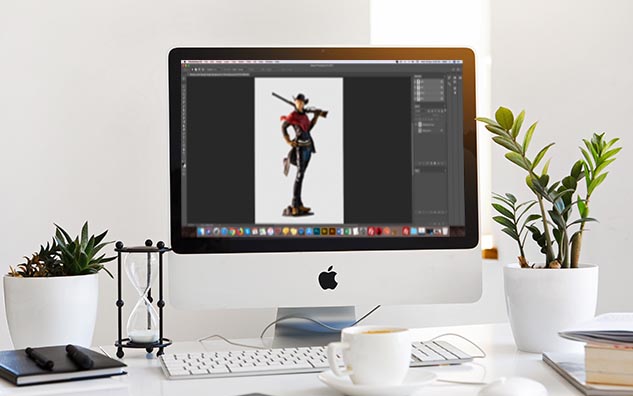In today’s digital era, there are lots of people using Photoshop, whether it’s for their business or just for fun.
Background removal is one of the key techniques that one needs to master while using Adobe Photoshop. It’s needed for most niches of professional photo editing.
This quick tutorial will show you how to remove the background in Photoshop. It may seem difficult to do, but by following this tutorial, you’ll be able to do it with ease.
What you’ll learn in this article
- 1 How to Remove Background in Photoshop Using Different Tools
- 1.1 Method 1: How to Remove Background Using the Quick Selection Tool
- 1.2 Method 2: How to Remove Background Using the Magic Wand Tool
- 1.3 Method 3: How to Remove Background Using Background Eraser Tools
- 1.4 Method 4: How to Remove Background Using Select Focus Area
- 1.5 Offshore Clipping Removes Image Background as per your Need
- 2 Final Thoughts
How to Remove Background in Photoshop Using Different Tools
Photoshop offers several tools to remove background from an image. You can use whichever you think suits best to your image. Here, we’ll talk about 4 methods to remove background from your image.
1. Quick Selection:
Quick Selection is absolutely what its name says. This is a quick solution to your background removing problem. It’ll find the edges and separate the subject from the background. After selecting your subject you can modify the selection too.
2. Magic Wand:
Magic Wand Tool separates the subject from the background by
reading color and tone. It doesn’t understand what is subject and what is background. It can’t read pixels too. It’ll identify similar colors and tones and select the subject based on that.
3. Background Eraser:
Like, Magic Wand Tool, this tool also can’t differentiate between subject and background. This separates one color from another. You just need to tell photoshop which color you want to keep and which you want to remove, doesn’t matter if it’s background or foreground, this tool will remove it.
Let’s explore these methods of removing the background.
4. Select Focus Area :
This method works by identifying the focus area of an image. This will select the focus area and mark it as the subject. So this method works best when your image has a sharp focus and your subject is clearly in focus.
Method 1: How to Remove Background Using the Quick Selection Tool
Step 1 : Open
Go to File and click on Open to open the file you want to work on.
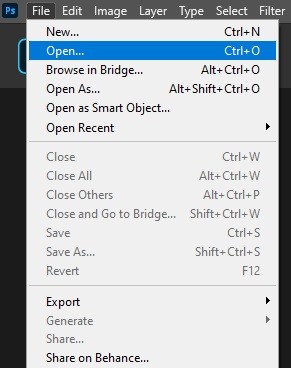
Step 2 : Duplicate Layer
Make a copy of the Background Layer. Right-click on the Background Layer and select Duplicate Layer. Or press Ctrl+J on the keyboard. This is for safety.
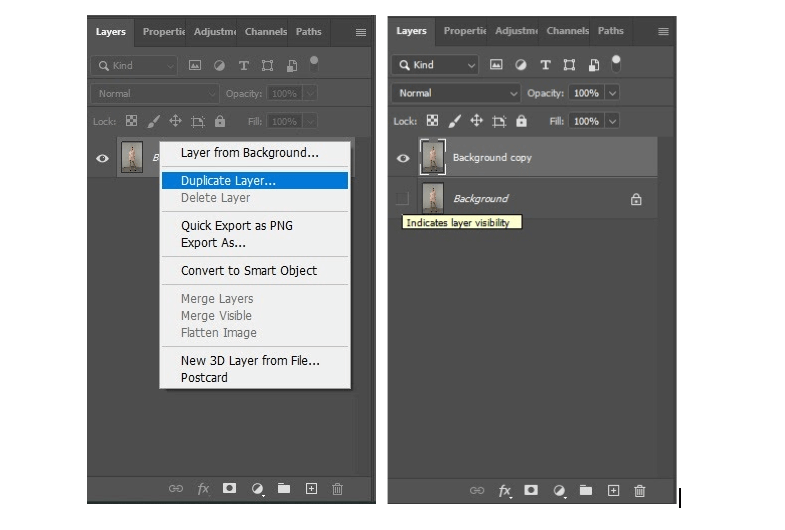
Hide the Background Layer by clicking on the Eye icon beside the layer.
Step 3 : Take the Tool
From the toolbar menu, select Quick Selection Tool. It’s at the upper portion of the toolbar.
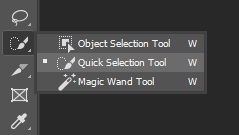
Step 4 : Select Subject
Now, click on Select Subject from the top menu.

This tool will automatically identify and select the subject by using artificial intelligence.

As this is artificial intelligence, there is a good possibility that it might not be able to select the area accurately. So, you’ll have to work on the selection.
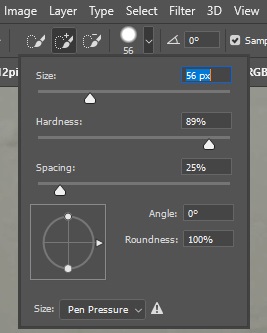
Adjust your brush size according to your need from the top menu.

If you want to include an area inside your selection, just click there. And if you want to remove an area from the selection, press Alt on your keyboard and then click on the area.
Step 5 : Add Layer Mask
When you’re satisfied with the selection, go to the Layer Panel and click on Layer Mask to add the mask.
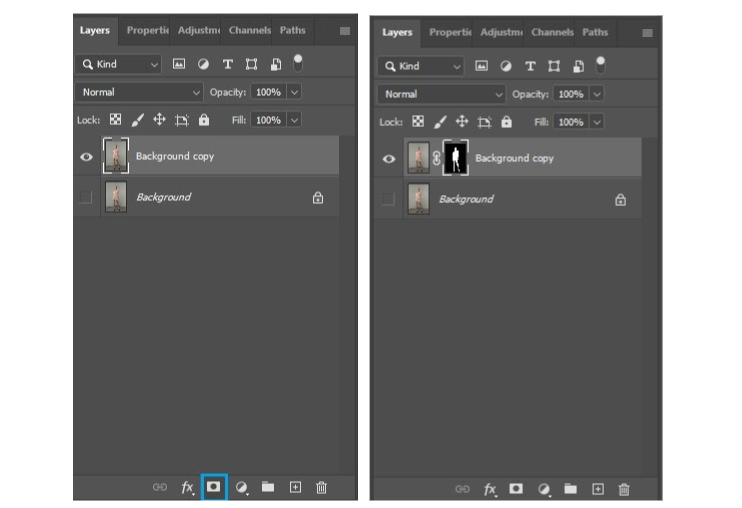
After adding the layer mask, your background will be removed.

Step 6 : Save
Go to File and click on Save As to save the image. Keep both jpeg and PSD files for future work.
Method 2: How to Remove Background Using the Magic Wand Tool
Step 1 : Open
From the top menu, select File and then click on Open and choose the file you want to work on.
Step 2 : Duplicate Layer
Make a copy of the Background Layer. Right-click on the Background Layer and select Duplicate Layer. Or press Ctrl+J on the keyboard. This is for safety.
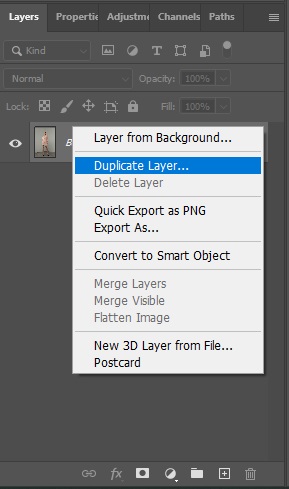
Hide the Background Layer by clicking on the Eye icon beside the Background Layer.
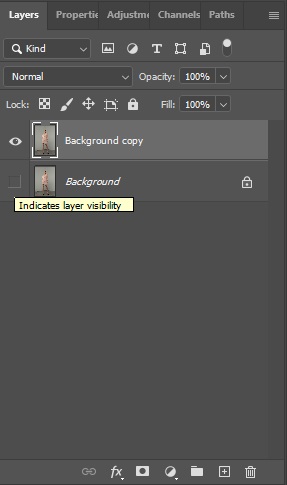
Step 3 : Take the Tool
Go to the toolbar and select the Magic Wand Tool. This is right under the Quick Selection Tool.
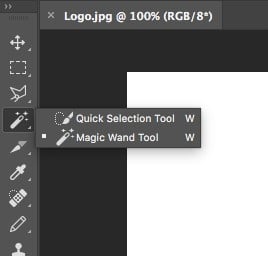
Step 4 : Adjust the Options
Now, adjust the options so that you can get a better selection. You’ll find these options on the top menu.

1. Tolerance
Tolerance level determines the range of color that this tool will select. The higher the tolerance level, the higher the range of selection. It’ll select the shades of color based on the tolerance number you set. So, if your subject and background have a similar color tone, choose a higher tolerance level. If not, keep it lower.
2. Contiguous
If it’s NOT marked, it will pick all the similar color tones that exist in the image with your first click. So, mark it to only select pixels that are connected to the first pixel.
3. Anti-Alias
This option will make the edge smoother and give the image a more natural look by softening the edges by allowing semi-transparent pixels to the image.
4. Sample All Layers
If there are multiple Layers in your image, marking this option will apply the changes on all the Layers. Otherwise, the changes will be on the current Layer only.
Step 5 : Configure the Tool
As the Magic Wand Tool works based on color and tone, you’ll have to pick the color of the background. Just click anywhere on the background and this tool will select the area with the same tone.

You might need to correct the selection. For that, click on add to selection and then click on the area you want to include.

Step 6 : Select and Mask
When your selection is done, go to the Select option. Under that, click on Select and Mask.
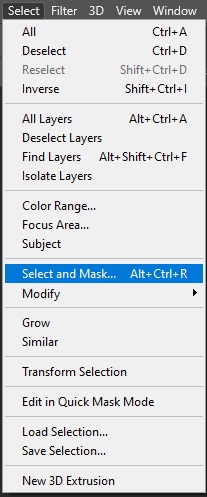
Step 7 : Refine Edges
Click on Invert to make your subject visible.

Now, shift the sliders if you need to smooth the edge or make any other changes. From the Output option, select New Layer with Layer Mask. And click on OK.
Step 6 : Save
Go to File, click on Save As and save the image as JPEG and PSD file.
Method 3: How to Remove Background Using Background Eraser Tools
Step 1 : Open
Go to File and select Open to open the file you’ll work on.
Step 2 : Duplicate Layer
Make a copy of the Background Layer. Right-click on the Background Layer and select Duplicate Layer. Or press Ctrl+J on the keyboard. This is for safety.
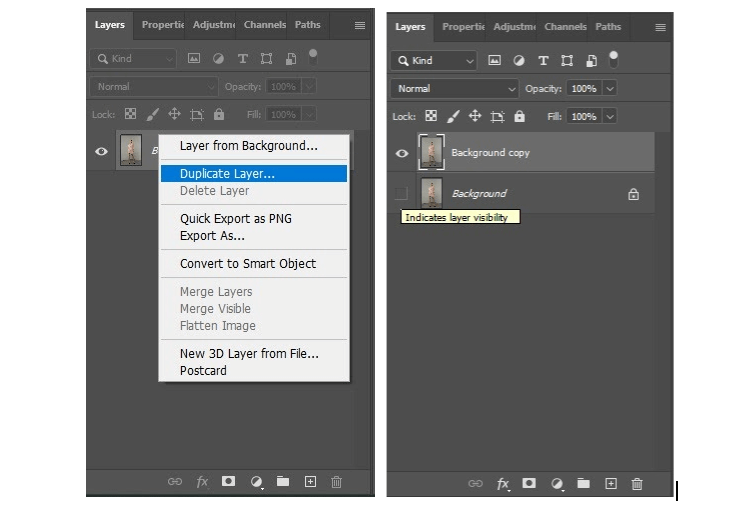
Hide the Background Layer by clicking on the Eye icon beside the layer.
Step 3 : Take the Eraser Tool
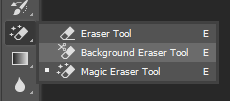
Step 4 : Adjust the options
You’ll find some options to adjust your selection at the top menu. Understand these options to apply these to your image properly-

1. Sampling Options
- Continuous: It’ll pick the sample every time you drag the brush.
- Once: It’ll pick the color you click at first and will remove only that color.
- Background Swatch: It will erase only the background color. You can give a sample of the color, and this will remove that particular color only.
2. Limits
- Contiguous: It’ll only pick the pixels that are touching the pixel under the + sign
- Discontiguous: This will erase everything that’s inside the big circle and that matches with the color you’re erasing.
- Find Edges: This will find the edges and separate that from the background.
3. Tolerance
This determines the sensitivity of the brush. Tolerance level depends on the area of your image you’re working on. So experiment with different tolerance levels which work best. If your subject and background have similar colors, keep the tolerance level lower.
4. Protect Foreground Color
Give photoshop a sample of your foreground color. And it won’t erase that color while brushing. Using this option will save your foreground color.

Step 5 : Set the Brush Size
From the top menu, set the Brush Size and hardness.
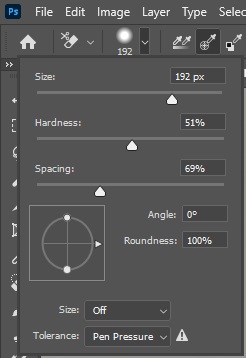
Step 6 : Erase the Background
Now, zoom the image according to your need so that you can see the edges clearly. Then start brushing on the background of your image. It‘ll remove the background immediately.

Be careful not to brush on your subject. This tool won’t recognize the subject. It’ll remove the area you’ll brush on.

Step 7 : Save
Save the image when you’re done. Go to File and click on Save As to save the file.
Method 4: How to Remove Background Using Select Focus Area
Step 1 : Open
Open the file by clicking on File and then Open.
Step 2 : Duplicate Layer
Make a copy of the Background Layer. Right-click on the Background Layer and select Duplicate Layer. Or press Ctrl+J on the keyboard. This is for safety.

Hide the Background Layer by clicking on the Eye icon beside the layer.
Step 3 : Take the Tool
Take Quick Selection or Magic Wand Tool from the Toolbar. Both are under the same menu.
Step 4 : Select Focus Area
Go to the Select menu from the top bar. Now click on Focus Area.
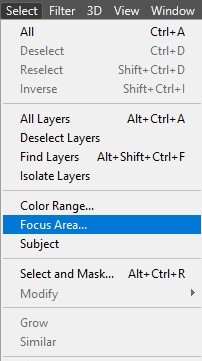
A box will pop up.
Step 5 : Adjust the options
Set the options according to your needs. You can change the In-Focus Range and Noise Level there.
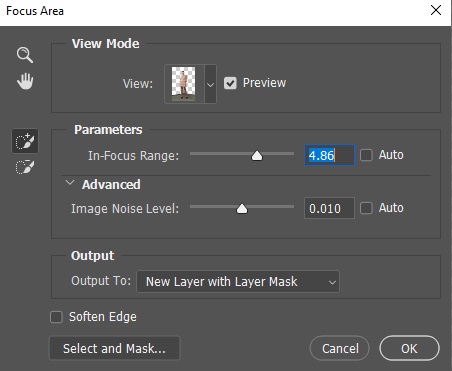
Set the Output to New Layer with Layer Mask.
Step 6 : Save
Go to File and Click on Save As to save the file. Choose format according to your need.
Offshore Clipping Removes Image Background as per your Need
Background removing is not something difficult, but you still might need assistance to do this work for so many reasons. For instance, when you have a large number of images, you can’t do that of your own. Also, to get professional quality work, you should reach the professionals.
Offshore Clipping is one of the best companies where you can get your photo editing works done. They have expert hands who are trained for specific jobs. You can get a free trial too. Most importantly, they will take care of your images as their own.
Most noteworthy, there you have several different ways you can remove a background in Photoshop and then replace it entirely on some other desired one. Certainly, it’s all yours to choose the method that works well for your situation.
Final Thoughts
As you can see by the process outlined above, the removal of background images in Photoshop is largely a multi-step process.
It’s not a difficult or complicated process, but it does involve several steps. And once you follow these steps point by point, you can rest assured to get it done!
